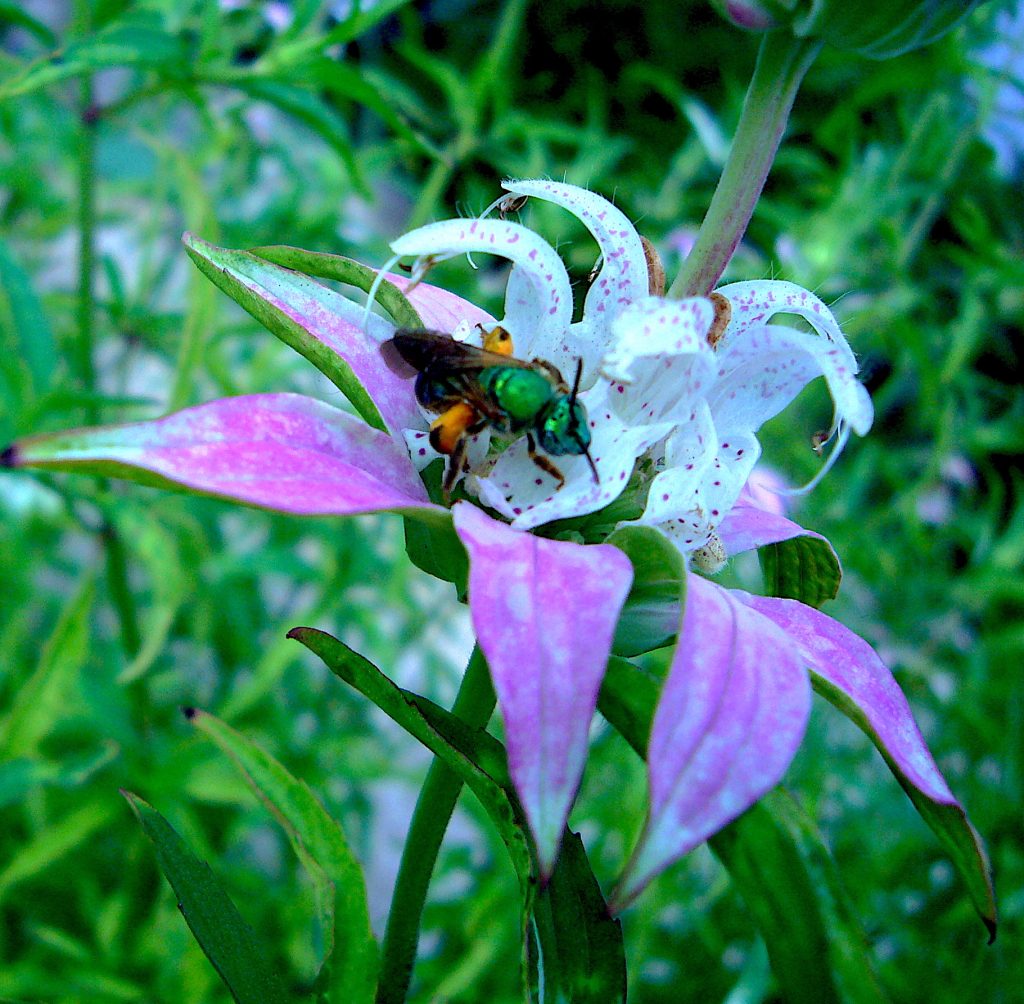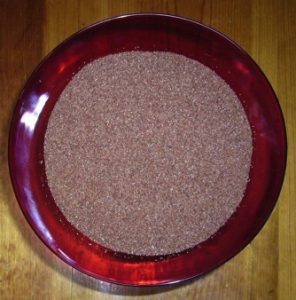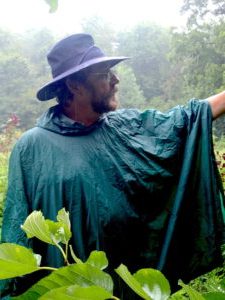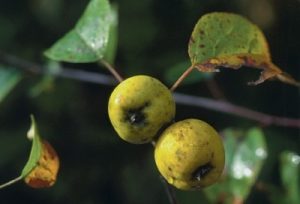
Monarda punctata, Horsemint, Bee Balm, in full blossom. Photo by Green Deane
We’ve mentioned it a few times in recent newsletters but it bares repeating one more time: Horsemint — see above — is in season and very easy to find now. Look in grassy sandy places or along paths in always dry areas. The pleasant side of the plant is that it smells nice and makes a Thyme-like spice. The naughty side of the species is that it contains Thymol which is a relaxant. Made into a tea it calms you down. How much it calms you down depends on how much you use and your personal response to it. You can also hang some in your house as an air freshener. You can read about Horsemint here.

Crowfoot Grass seeds are gluten free. Photo by Green Deane
Crowfoot Grass, which is starting to ripen now, is not native to North America. It’s from Africa where the species is used to make unleavened bread and a frothy beer. While crowfoot grass is easy to harvest — when ripe — the grains are tiny, eye of a needle size. You can collect about two quarts an hour — making them calorie positive — and they can grow in large colonies making harvesting easy. Usually you collect the grains while sitting and using window screen plastic as a strainer. The grains have a small amount of cyanide in them but drying and cooking drives that off. Though minute botanically they are a mouthful: Dactyloctenium aegyptium. That means ‘little comb fingers from Egypt.’ You can find Crowfoot Grass from Maine to California skipping the upper northwest side of the country.

Classes are held rain or shine.
Last Saturday’s plant foraging class in Gainesvile almost turned into a mushroom class because we saw so many species. There were Chanterelles by the hundreds, Indigo Milk Caps and other Milk Caps and a variety of Boletes. Sunday’s class near Daytona Beach wasn’t a washout but almost was. One dry area I checked out at 8 a.m. was by 11 — with the tide and on-shore wind — almost knee deep in water. We managed to slosh on to see out local Goji Berry in blossom. Rain might be the case with my upcoming Saturday class in Ft. Pierce. By Thursday or Friday a low that went south might come back north as a rain maker. We’ll just have to see. Whether the potential rain makes it far enough north for Sunday’s class in Palm Harbor is an unknown. I hold classes in the rain unless its reaching tropical storm or hurricane conditions.
Saturday, September 26th, George LeStrange Preserve, 4911 Ralls Road, Fort Pierce, FL, 34981, 9 a.m. to noon. This location does not have an official bathroom. Plan accordingly. There also may be some flooding which might alter our normal walk around the area.
Sunday, September 27th, John Chestnut County Park: 2200 East Lake Road, Palm Harbor, FL 34685. Nine a.m. to noon. Meet at the trail head of the Peggy Park Nature Walk.
Saturday, October 3rd, Mead Garden, 1500 S. Denning Dr. Winter Park, FL 32789. 9 a.m. to noon, meet by the bathrooms. Note this is Mead Garden just northeast of Orlando. Not Ft. Mead which is 90 miles further south. Also the entrance to Mead Garden is on the west side on S. Denning Drive, Winter Park. Some GPS programs put the entrance on the east side on S. Pennsylvania Avenue, Winter Park. That was decades ago.
Sunday, October 4th, Tide Views Preserve, 1 Begonia Street, Atlantic Beach Fl 32233 (near Jacksonville Fl.) 9 a.m. to noon. Meet near the main bathrooms. 9 a.m. to noon. There is no charge for this class but donations will be accepted. The reason is this is it’s an exploratory class at a new location. Let’s find out what’s there together. For more information, to pre-pay or to sign up for a class go here.

Wild and cider apples can be bitter.
Apple season is upon us, depending where you live. When I was a kid back in the BC era — Before Computers — I always associated going back to school with raiding apple trees. (We always went back to school on the Tuesday after Labor Day.) I also raided the concord grapes in the nearby hedge rows as well. The actual word for that is “scrumping” (which was an actual verb for juvenile fruit stealing long before modern slang added other meanings.) There were orchard apples trees and there were wild apple trees. Sometimes the wild apples were from cultivated apples that grew up literally from a tossed apple core. Other times they were real wild apples, small and tart if not bitter. Those were usually better off cooked by a camp fire along a river while fishing after school. I walked or biked four miles to school daily and often didn’t get home until after dark (which means I thankfully missed anything my mother tried to cook.) Where I grew up there were many abandoned homesteads with flourishing apple trees in unused yards. There is something philosophical knowing the cared-for apple tree outlived family and home. Back then there was also a greater variety of apples than even just a few decades later because of mechanization. Even when I was young there was a great diversity of apples. Some would not store at all — eating apples — some that would stay hard for months only softening in mid-winter or spring. Others were only good for cider or cooking and or just jelly. And contrary to common belief, apples will grow in Florida. I recommend Apple Anna, a very nice blush. To read more about apples go here.

The nose doesn’t always know.
The aroma of a wild food is the most flexible of all descriptions. This is for two reasons: Noses differ and plants differ. Taste is also quite flexible but aroma variations beat taste out. When you read in a foraging guide, or even in my articles, that a plant smells like such-and-such know that the description is quite subjective. There are several local species that elicit different descriptions even when noses are whiffing the same sample. One low-growing fruit — the Gopher Apple — has been described as smelling like pink bubble gum, a new plastic shower curtain, or no aroma at all. The smelly spice Epazote ranges in opinions from citrusy to floor varnish to industrial cleaner. Even among non-edibles the olfactory estimations can vary such as with the toxic Laurel Cherry. Some think its cyanide smells like almonds, other think they smell maraschino cherries, some can’t smell the cyanide at all. In guide books a reported aroma is just that, a guide. It is not always for certain by any means. There’s room for aromatic latitude.

Carl Linnaeus had a dirty mind.
Plant Pronunciations: What’s really important is knowing the plant and whether you can eat it or not. What you call it is secondary. Common names are okay as long as you know many plants can have the same common name. “Indian Potato” comes to mind. There are two problems with common names. You and someone else could be talking about the “Indian Potato” but actually be talking about two different species. Also every plant — in theory — has one botanical name but can have virtually dozens of common names. Many times it is just easier to remember the one botanical name. Dead Latin was chosen for the naming plants because … well… it’s dead, non-changing, non-evolving. Perhaps it was also chosen by academics as a way to keep Latin from disappearing completely. Another possibility was they wanted to use naughty descriptions and if in Latin most wouldn’t know how lewd some names are. But know even when Latin was spoken it had regional accents and far flung Latin became French, Spanish and Romanian. At home it became Italian. There is no etched-in-granite correct way to pronounce botanical names. Hmmmm…. take Vagus. It can be said like the city, Los Vegas, or vah-GOOSE. It means literally “wandering.” And of course there are different pronunciations botanical names in American English vs British English such as with the pine genus (PINE-us, vs. PEEN-iss.)
Many “Latin” plant names are mangled Greek. Take the genus Dioscorea, the true yams. Dead Latin has it dye-oh-SCORE-ree-ah. That makes my ears hurt. It’s named after a Greek physician, Dioscorides, 40-90 AD. So I prefer thee-oh-score-REE-dez which closer to the Greek way of saying it. The only time the botanical name is truly important is to make sure the two of you are discussing the same plant. This happened recently when I received an email from Singapore about how to use the Skunk Vine. There are several Skunk Vines (like Indian Potatoes, Hog Plums et cetera.) As we were exchanging information about Paederia foetida without the botanical name that would have been difficult. Scientific names of any species can be a personal hurdle. And some times you don’t have a choice. The majority of mushrooms do not have a common names. You just have to bite the Boletus.

Green Deane videos are now available on a USB.
Changing foraging videos: My nine-DVD set of 135 videos has been selling for seven years and are still available. They are the same videos I have on You Tube. Some people like to have a separate copy. A second option is a16-gig USB that has those 135 videos plus 15 more. While the videos can be run from the DVDs the videos on the USB have to be copied to your computer to play. They are MP4 files. The150-video USB is $99 and the 135-video DVD set is now $99. The DVDs will be sold until they run out then will be exclusively replaced by the USB. This is a change I’ve been trying to make for several years. So if you have been wanting the 135-video DVD set order it now as the price is reduced and the supply limited. Or you can order the USB. My headache is getting my WordPress Order page changed to reflect these changes. We’ve been working on it for several weeks. However, if you want to order now either the USB or the DVD set make a $99 “donation” using the link at the bottom of this page or here. That order form provides me with your address, the amount — $99 — tells me it is not a donation and in the note say if you want the DVD set or the USB.

Green Deane Forum
Want to identify a plant? Perhaps you’re looking for a foraging reference? You might have a UFO, an Unidentified Flowering Object, you want identified. On the Green Deane Forum we — including Green Deane and others from around the world — chat about foraging all year. And it’s not just about warm-weather plants or just North American flora. Many nations share common weeds so there’s a lot to talk. There’s also more than weeds. The reference section has information for foraging around the world. There are also articles on food preservation, and forgotten skills from making bows to fermenting food. This is weekly newsletter #424, If you want to subscribe to this free newsletter you can find the sign-up form in the menu at the top of the page.
To donate to the Green Deane Newsletter click here.


